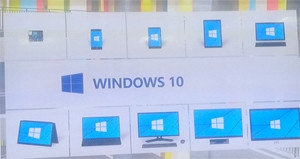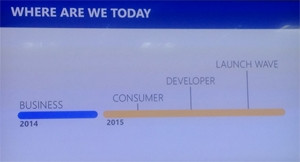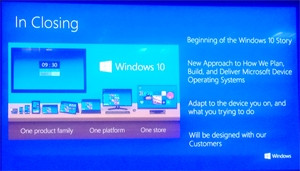
Post the Windows 10 announcement made recently, Microsoft held a technical briefing to explain the new Microsoft thinking. Zoaib Hoosen, Microsoft South African MD, clarified that Windows 10 is not just the new version of Windows, but rather a next-generation platform that is going to be designed not just by the Microsoft team, but in conjunction with customers and partners.
Wait. What? This is a very different Microsoft.
In the past, a software release of the company consisted of an almost completed product that was available to developers and those who signed up for the various Microsoft programs. Feedback was accepted, which consisted of mainly bug fixes and hardware/driver issues, and then the software was released to the public. Naturally, the more people who used the software would result in more bugs reported, and these would be fixed with software updates.
Old school
That was Microsoft of old. Microsoft of today wants a much more collaborative, hands-on involvement from customers to shape the new platform. Referred to as the Windows Insider Program (WIP), this is the Microsoft's largest ever open collaborative development effort to change the way Windows is built and delivered to best meet the needs of customers. It is, of course, understood that this is not for everyone, but rather for those technical people who are able and willing to report back to Microsoft not only about their bugs, but also their experiences (both positive and negative). Feedback will be submitted via the Windows Feedback app for the sharing of suggestions and issues, as well as a Windows Technical Preview Forum to interact with Microsoft engineers and fellow insiders.
In other words, from Microsoft's announcement of Windows 10, until it is commercially available, which is said to be in late 2015, Microsoft is essentially using the "wisdom of the crowds" to crowdsource the best release of the next-generation Windows platform. Anthony Doherty, Windows Business Group lead, refers to this as "inviting [the customer] to come on a journey".
Very smart.
Having customers and partners involved right from the early stage and essentially steering the development should ensure the release of Windows 10 will suit their environment perfectly and be the ideal platform - not just on desktop, but sneakily, on tablets, mobiles and other connected devices too.
The ideal customer to have is one that helps to build their own product to buy from you. "Build it and they will come" is now "let them build it and they will buy it".
Talk about a win-win situation for Microsoft and its customers.
Key items stood out for me in the briefing:
One system of familiarity:

Windows 10 goes back to its root of familiarity. There is the 'Start' button, the 'windows and mouse' interaction and the apps loading inside a window. These are the hallmarks of the Windows family. There is also the touch and tile ability of Windows 8 for those devices that require a touch interface. With Windows 10, the same operating system, Kernel, and architecture will power devices of the Internet of Things, tablets, phones, gaming consoles, PCs and large PPI screens. Developers will be able to customise the interface to adapt to the size and the ability of the device.
Microsoft is basing everything on 'Cloud First, Mobile First', and with Windows 10, there is:
* One universal app platform;
* One security model;
* One management system;
* One deployment approach; and
* One familiar experience.
This 'one-ness' allows developers to have better control over their app and be able to deploy more innovation even into mission-critical systems. One management system and the same deployment approach to all.
Add desktop function:
Windows 10 gives the user the ability to set up different views of the desktop, depending on the user's needs at a particular point. The same user can have a work desktop with business application and a kids' desktop that will only have apps and games. This is similar to the current ability to have multiple users on the same computer, each with their own profile, icons and apps - but this time, with Windows 10, there will not be a requirement to log in and out.
Active Directory integration:
Windows 10 and Microsoft Store will have a tighter integration into the Active Directory. No longer will the enterprise have to create individual Hotmail accounts to log into the store. This tighter integration will also allow the enterprise to have its own curated app store of work-approved apps, as well as the ability to manage the licensing of apps to individuals, which can be revoked should that person leave the company.
Upgrade, not replace:

Windows 10 will be an update of Windows 7 and Windows 8, and will no require a 'rip and replace'. This is key for those businesses that have invested in Windows 7 and 8, and especially important for those companies which have invested time and money into rolling out Windows into their organisation. They can now safely install Windows 7 knowing their investment will not be wasted within a year.
How to get an early copy of Windows 10?
If you want to get your hands on an early preview copy of Windows 10, check out these links:
http://Technet.microsoft.com/en-us
http://Preview.windows.com
Share